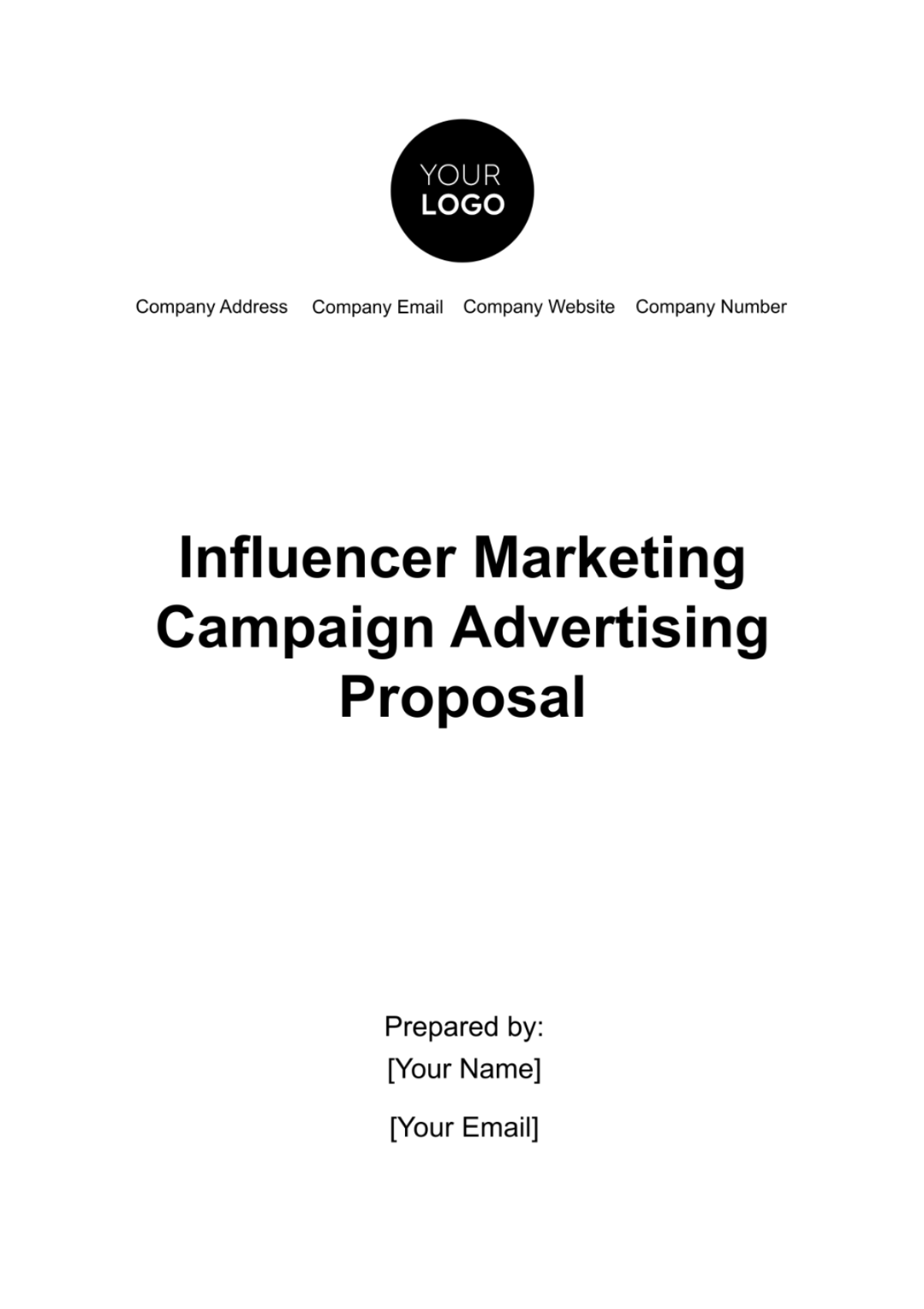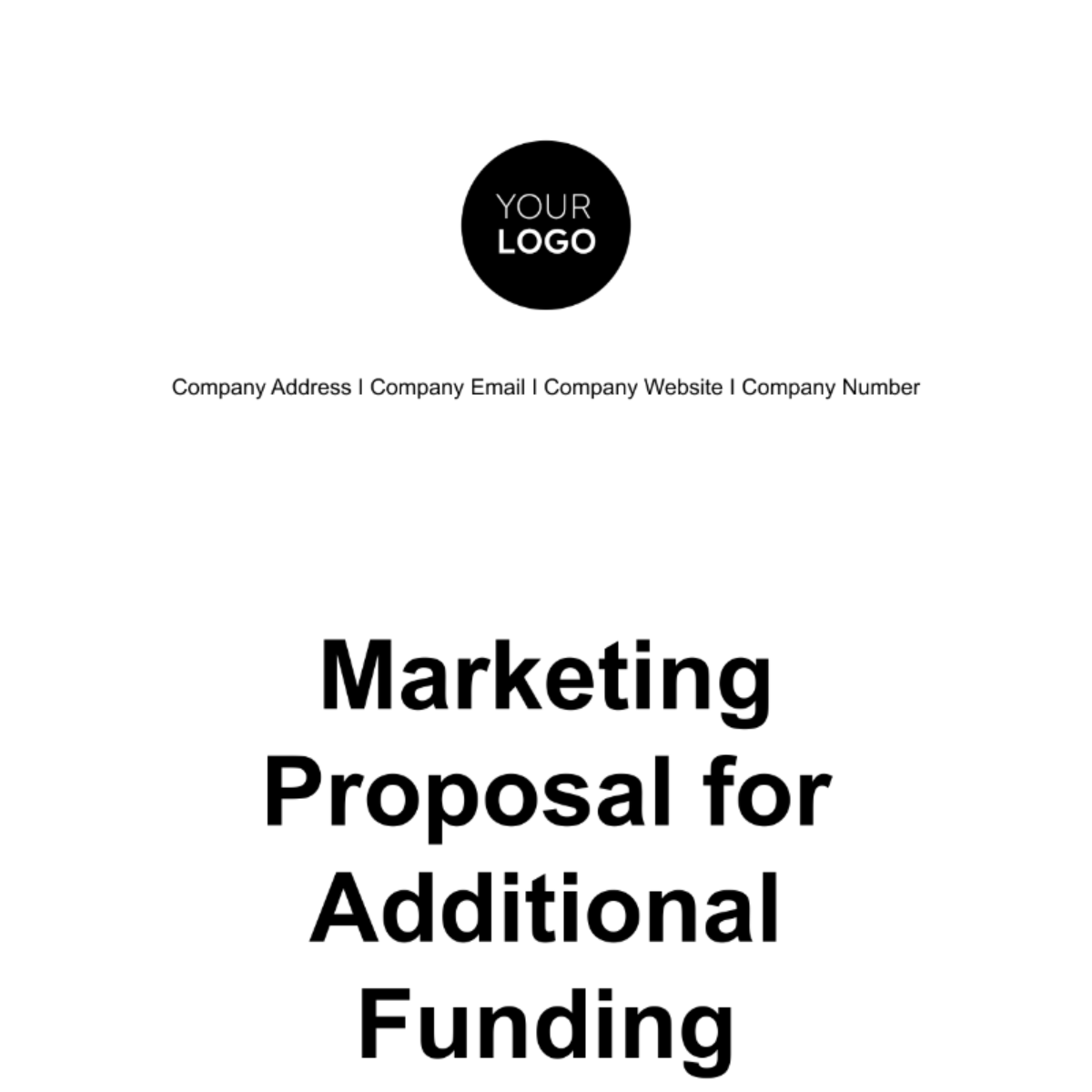Custom Marketing Proposal
I. Executive Summary
A. Overview of Proposal
This proposal provides a tailored marketing strategy for [Second Party], aiming to boost brand recognition and drive substantial business growth. Our plan integrates cutting-edge digital marketing techniques with traditional approaches to deliver a cohesive and effective campaign. We will utilize advanced analytics to track performance and refine our strategies for optimal results. Our approach is designed to align with [Second Party]’s vision and long-term goals.
B. Key Objectives
The main objectives are to increase website traffic by [00]% and enhance social media engagement by [00]% within the next six months. Additionally, we aim to generate a [00]% increase in qualified leads through targeted marketing efforts. These goals are set to ensure measurable growth and a stronger market presence. Achieving these objectives will significantly contribute to [Second Party]’s overall success and competitive edge.
C. Summary of Recommended Strategies
We recommend a multi-faceted strategy incorporating SEO, PPC, social media marketing, and content creation to drive traffic and engagement. Each component of our strategy is designed to address specific aspects of [Second Party]’s marketing needs. We will leverage data-driven insights to optimize campaigns and maximize return on investment. This holistic approach ensures comprehensive coverage and effective results.
II. Client Analysis
A. Company Background
[Second Party] is a prominent player in the [Industry] sector, known for its [Products/Services] and commitment to excellence. Founded in [Year], the company has built a strong reputation and established a loyal customer base. With a focus on innovation and quality, [Second Party] has achieved significant milestones in its growth trajectory. Understanding its history and values is crucial for crafting a marketing strategy that resonates with its brand identity.
B. Market Position
[Second Party] occupies a competitive position in the market, distinguished by its unique offerings and customer-centric approach. Despite its strong presence, there are opportunities to enhance visibility and market share through targeted marketing initiatives. Analyzing market trends and customer preferences will help identify areas for growth and improvement. Strengthening market position will enable [Second Party] to better compete and expand its reach.
C. Target Audience
The primary target audience for [Second Party] includes professionals aged 25-45 who are located in [Regions]. This demographic is typically employed in industries such as [Industry] and holds mid to senior-level positions. They have a higher disposable income and are more likely to invest in [Second Party]’s products or services. Understanding these demographics allows us to tailor messaging and offers that resonate with their specific needs and preferences.
D. Competitor Analysis
Key competitors in the [Industry] include [Competitor 1], [Competitor 2], and [Competitor 3], each with its own strengths and market strategies. Analyzing their marketing tactics and market positioning will provide valuable insights into potential opportunities and threats. Understanding competitors’ strengths and weaknesses will help identify areas where [Second Party] can differentiate itself. Our strategy will leverage these insights to develop unique value propositions and gain a competitive advantage.
III. Marketing Objectives
A. Primary Goals
Our primary goal is to increase website traffic by [00]0% within the next six months through enhanced SEO and targeted PPC campaigns. We also aim to achieve a [00]% increase in social media engagement by creating compelling content and interactive campaigns. Generating [00]% more leads from digital channels will be a key focus, supported by optimized landing pages and effective call-to-actions. These goals are designed to drive measurable growth and improve overall marketing effectiveness.
B. Secondary Goals
In addition to the primary goals, we aim to enhance brand recognition within the target market by increasing visibility through strategic campaigns. Improving customer retention rates will be a focus, achieved through personalized marketing and targeted outreach. Establishing [Second Party] as a thought leader in the [Industry] will be pursued by publishing industry insights and engaging content. These secondary goals will support long-term brand development and customer loyalty.
C. Key Performance Indicators (KPIs)
To measure success, we will track website traffic using Google Analytics, focusing on metrics such as page views, bounce rate, and time on site. Social media engagement will be assessed through metrics like likes, shares, comments, and follower growth. Lead conversion rates will be monitored through CRM systems to evaluate the effectiveness of lead generation efforts. ROI will be calculated by comparing the cost of marketing initiatives against the revenue generated.
IV. Strategic Approach
A. Overall Strategy
Our overall strategy combines digital and traditional marketing methods to create a unified brand message and maximize impact. We will employ a data-driven approach, continuously analyzing performance to refine and enhance our tactics. The strategy will be adaptable, allowing for adjustments based on real-time insights and market conditions. Our goal is to ensure that all marketing efforts are aligned with [Second Party]’s business objectives and deliver measurable results.
B. Digital Marketing Strategies
Search Engine Optimization (SEO)
We will implement a comprehensive SEO strategy, focusing on both on-page and off-page optimization to improve search engine rankings. This includes keyword research, content optimization, and building high-quality backlinks. Technical SEO will also be addressed to enhance site performance and user experience. Regular performance audits and adjustments will ensure that our SEO efforts continue to drive traffic and achieve desired outcomes.
Pay-Per-Click Advertising (PPC)
Our PPC campaigns will target relevant keywords and demographics to drive highly qualified traffic to [Second Party]’s website. We will use advanced targeting options and data analytics to optimize ad placements and improve click-through rates. A/B testing will be employed to determine the most effective ad copy and landing pages. Continuous monitoring and optimization will ensure that the PPC campaigns deliver maximum return on investment.
Social Media Marketing
The social media strategy will include creating and sharing engaging content across platforms such as Facebook, Instagram, and LinkedIn. We will utilize targeted ads and promotions to reach the desired audience and boost engagement. Interactive elements, such as polls and contests, will be incorporated to increase interaction and brand loyalty. Performance metrics will be tracked to evaluate the success of social media campaigns and refine strategies as needed.
Content Marketing
A content marketing plan will be developed to produce high-quality, relevant content that resonates with [Second Party]’s target audience. This includes blog posts, infographics, and whitepapers that provide valuable insights and address customer pain points. Content will be optimized for SEO to drive organic traffic and establish [Second Party] as an industry authority. We will also explore content distribution strategies to maximize reach and engagement.
C. Offline Marketing Strategies
Print Advertising
We will design visually appealing print ads for placement in industry magazines and local publications. The ads will highlight [Second Party]’s key offerings and unique value propositions. Strategic placement in relevant publications will target potential customers who prefer traditional media. Print advertising will complement digital efforts and enhance overall brand visibility.
Events and Sponsorships
Participation in industry events and local sponsorships will provide opportunities for direct engagement with potential customers and partners. We will identify relevant events that align with [Second Party]’s brand and objectives. Sponsoring events or hosting booths will increase brand exposure and foster relationships with the target audience. Post-event follow-up will be essential for converting leads and maintaining engagement.
D. Customer Relationship Management (CRM) Strategies
We will implement a robust CRM system to manage and analyze customer interactions, track leads, and enhance personalized marketing efforts. The CRM will enable targeted communication and automate follow-up processes, improving customer satisfaction and retention. Detailed analytics will provide insights into customer behavior and preferences, guiding future marketing strategies. Regular reviews of CRM data will ensure that our approach remains aligned with customer needs and business goals.
V. Implementation Plan
A. Detailed Action Plan
Month 1 | Launch SEO and PPC campaigns, initiate content creation, and begin social media outreach. Set up tracking tools and analytics to monitor performance from the outset. Develop and execute a content calendar to ensure timely and relevant postings. Establish baseline metrics for comparison and evaluation throughout the project. |
Month 2 | Expand offline marketing efforts with print ads and event planning. Review initial campaign performance and make necessary adjustments based on data insights. Begin outreach for events and secure sponsorship opportunities. Continue optimizing digital marketing efforts to enhance effectiveness. |
Month 3-6 | Execute planned events and monitor ongoing marketing activities. Regularly review performance metrics and adjust strategies to address any issues or opportunities. Provide monthly performance reports and make strategic recommendations for improvements. Prepare for the final evaluation and presentation of results. |
B. Timeline and Milestones
Week 1 | Finalize strategy details and begin implementation of digital marketing efforts. Set up tracking and reporting systems to capture performance data. Conduct initial team meeting to outline roles and responsibilities. Ensure all marketing materials and content are prepared for launch. |
Month 2 | Complete the first round of performance reviews and adjustments. Begin executing offline marketing strategies, including print advertising and event participation. Conduct a mid-project review to assess progress and make any necessary strategic changes. Communicate with stakeholders to provide updates and gather feedback. |
Month 6 | Conduct a comprehensive evaluation of all marketing activities. Assess the overall impact and effectiveness of the strategies against the set objectives. Prepare a final report summarizing results, insights, and recommendations. Schedule a wrap-up meeting to discuss outcomes and next steps. |
C. Responsibilities and Team Members
Project Manager | Oversees the execution of the marketing plan, ensuring alignment with objectives and timely delivery of milestones. Coordinates between team members and stakeholders, and manages the overall project budget and timeline. |
SEO Specialist | Focuses on optimizing the website and content for search engines to improve rankings and drive organic traffic. Monitors SEO performance and implements adjustments based on analytics and industry best practices. |
PPC Specialist | Manages pay-per-click advertising campaigns, including keyword research, ad creation, and performance tracking. Works to maximize ROI through targeted ad placements and ongoing campaign optimization. |
Content Creator | Develops engaging and high-quality content for various platforms, including blog posts, infographics, and social media updates. Ensures that content aligns with the overall marketing strategy and is optimized for SEO. |
Social Media Manager | Executes social media campaigns and manages interactions on platforms like Facebook, Instagram, and LinkedIn. Analyzes social media metrics to assess engagement and refine strategies for better results. |
VI. Budget
A. Breakdown of Costs
Category | Amount | Definition |
|---|---|---|
SEO and PPC | $[00] | This includes costs for keyword research, on-page and off-page SEO optimization, and ongoing management of PPC campaigns. It covers ad spend, click costs, and the implementation of tracking tools and analytics. |
Content Creation | $[00] | This covers the production of high-quality content such as blog posts, infographics, whitepapers, and videos. Costs also include graphic design, copywriting, and content optimization. |
Social Media Management | $[00] | Includes the cost of developing and managing social media campaigns, including ad spend, content creation, and community management. It also covers analytics and performance tracking tools. |
Print Advertising | $[00] | Covers the design, production, and placement of print ads in relevant industry magazines and local publications. It includes both the creative and distribution costs. |
Events and Sponsorships | $[00] | This includes fees for event participation, sponsorships, booth setup, and promotional materials. It also covers any associated travel and accommodation costs for event staff. |
B. Estimated Return on Investment (ROI)
The anticipated ROI is projected to be [00]%, based on a detailed analysis of historical data and industry benchmarks. We expect significant revenue increases from enhanced brand visibility, higher website traffic, and increased lead generation. The ROI calculation will consider both direct revenue and long-term brand value improvements. Ongoing performance monitoring will ensure that investments are delivering the expected returns.
C. Payment Terms and Schedule
Payments will be structured in three installments to align with project milestones:
[00]% Upfront: To cover initial setup costs, including strategy development and campaign launch.
[00]% Mid-Point: To support ongoing implementation, including campaign management and optimization.
[00]% Upon Completion: Following the final evaluation and delivery of the comprehensive performance report. Detailed invoices will be provided at each payment stage, and payment terms are net 30 days from invoice date.
VII. Measurement and Evaluation
A. Metrics for Success
Success will be measured through several key metrics:
Traffic Growth: Monitored via Google Analytics, focusing on increases in page views, unique visitors, and session duration.
Engagement Levels: Assessed through social media analytics, including likes, shares, comments, and overall follower growth.
Lead Conversion Rates: Tracked using CRM systems to evaluate the number of leads generated and their conversion into customers.
ROI: Calculated by comparing the total cost of marketing activities against the revenue generated, ensuring that the investments are yielding favorable returns.
B. Reporting Schedule
Performance will be reported on a monthly basis, including detailed analytics and insights for each marketing channel. Regular updates will be provided to keep stakeholders informed of progress and results. A mid-project review will be conducted to assess the effectiveness of strategies and make necessary adjustments. A final comprehensive report will summarize overall performance, achievements, and recommendations for future actions.
C. Adjustments and Optimizations
Based on performance data and feedback, we will implement adjustments to optimize marketing strategies. This may include refining targeting parameters, modifying ad creatives, or reallocating budgets to more effective channels. Continuous analysis will ensure that campaigns remain aligned with objectives and adapt to changing market conditions. Regular optimization will maximize results and improve overall campaign effectiveness.
VIII. Conclusion
A. Recap of Proposal
This proposal presents a strategic marketing plan designed to enhance [Second Party]’s market presence and drive significant growth. Our comprehensive approach combines digital and offline marketing efforts, tailored to address the specific needs and goals of [Second Party]. The proposed strategies are aimed at achieving measurable results and positioning the company for long-term success. We are committed to delivering a high-impact campaign that aligns with your vision and objectives.
B. Next Steps
To move forward, we recommend scheduling a meeting to discuss the proposal in detail and finalize the implementation plan. This meeting will provide an opportunity to review any questions or concerns and make any necessary adjustments to the plan. Upon approval, we will proceed with the outlined strategies and begin executing the action plan. We look forward to collaborating with you to achieve your marketing goals.
C. Contact Information
For further discussion or questions regarding this proposal, please contact:
[Your Name]
[Your Position]
[Your Company Name]
[Your Company Email]
[Your Company Number]
We are available to provide additional information and support throughout the project. Thank you for considering our proposal, and we look forward to the opportunity to work together.

















































